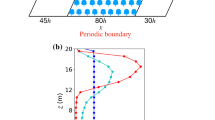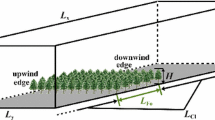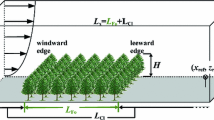Abstract
Numerical simulations of neutral flow over a two-dimensional, isolated, forested ridge are conducted to study the effects of scalar source distribution on scalar concentrations and fluxes over forested hills. Three different constant-flux sources are considered that span a range of idealized but ecologically important source distributions: a source at the ground, one uniformly distributed through the canopy, and one decaying with depth in the canopy. A fourth source type, where the in-canopy source depends on both the wind speed and the difference in concentration between the canopy and a reference concentration on the leaf, designed to mimic deposition, is also considered. The simulations show that the topographically-induced perturbations to the scalar concentration and fluxes are quantitatively dependent on the source distribution. The net impact is a balance of different processes affecting both advection and turbulent mixing, and can be significant even for moderate topography. Sources that have significant input in the deep canopy or at the ground exhibit a larger magnitude advection and turbulent flux-divergence terms in the canopy. The flows have identical velocity fields and so the differences are entirely due to the different tracer concentration fields resulting from the different source distributions. These in-canopy differences lead to larger spatial variations in above-canopy scalar fluxes for sources near the ground compared to cases where the source is predominantly located near the canopy top. Sensitivity tests show that the most significant impacts are often seen near to or slightly downstream of the flow separation or reattachment points within the canopy flow. The qualitative similarities to previous studies using periodic hills suggest that important processes occurring over isolated and periodic hills are not fundamentally different. The work has important implications for the interpretation of flux measurements over forests, even in relatively gentle terrain and for neutral flow. To understand fully such measurements it is necessary not only to understand the flow structure (given the site characteristics) but also to know the distribution of scalar sources and sinks in the canopy.









Similar content being viewed by others
References
Aubinet M, Berbigier P, Bernhofer CH, Cescatti A, Feigenwinter C, Granier A, Grünwald TH, Havrankova K, Heinesch B, Longdoz B, Marcolla B, Montagnani M, Sedlak P (2005) Comparing CO2 storage and advection conditions at night at different CARBOEUROFLUX sites. Boundary-Layer Meteorol 116:63–94. doi:10.1007/s10546-004-8
Belcher SE, Newley TMJ, Hunt JCR (1993) The drag on an undulating surface induced by the flow of a turbulent boundary layer. J Fluid Mech 249:557–596. doi:10.1017/S0022112093001296
Belcher SE, Finnigan JJ, Harman IN (2008) Flows through forest canopies in complex terrain. Ecol Appl 18:1436–1453. doi:10.1890/06-1894.1
Belcher SE, Harman IN, Finnigan JJ (2012) The wind in the willows: flows in forest canopies in complex terrain. Annu Rev Fluid Mech 44:479–504. doi:10.1146/annurev-fluid-120710-101036
Bohrer G, Katul GG, Walko RL, Avissar R (2009) Exploring the effects of microscale structural heterogeneity of forest canopies using large-eddy simulations. Boundary-Layer Meteorol 132(3):351–382. doi:10.1007/s10546-009-9404-4
Feigenwinter C, Bernhofer C, Eichelmann U, Heinesch B, Hertel M, Janous D, Kolle O, Lagergren F, Lindroth A, Minerbi S, Moderow U, Mölder M, Montagnani L, Queck R, Rebmann C, Vestin P, Yernaux M, Zeri M, Ziegler W, Aubinet M (2008) Comparison of horizontal and vertical advective \(\text{ CO }_2\) fluxes at three forest sites. Agric For Meteorol 148(1):12–24. doi:10.1016/j.agrformet.2007.08.013
Finnigan JJ (1999) A comment on the paper by Lee (1998) On micrometeorological observations of surface-air exchange over tall vegetation. Agric For Meteorol 97:55–64. doi:10.1016/S0168-1923(99)00049-0
Finnigan JJ (2000) Turbulence in plant canopies. Annu Rev Fluid Mech 32:519–571. doi:10.1146/annurev.fluid.32.1.519
Finnigan JJ (2004) The footprint concept in complex terrain. Agric For Meteorol 127:117–129. doi:10.1016/j.agrformet.2004.07.008
Finnigan JJ, Belcher SE (2004) Flow over a hill covered with a plant canopy. Q J R Meteorol Soc 130:1–29. doi:10.1256/qj.02.177
Finnigan JJ, Harman IN, Ross AN, Belcher SE (2015) First order turbulence closure for modelling complex canopy flows. Q J R Meteorol Soc (in press)
Goulden ML, Miller SD, da Rocha HR (2006) Nocturnal cold air drainage and pooling in a tropical forest. J Geophys Res Atmos 111(D8):D08S04. doi:10.1029/2005JD006037
Grant ER, Ross AN, Gardiner BA, Mobbs SD (2015) Field observations of canopy flow over complex terrain. Boundary-Layer Meteorol Online First:1–21, doi:10.1007/s10546-015-0015-y
Harman IN, Finnigan JJ (2008) Scalar concentration profiles in the canopy and roughness sublayer. Boundary-Layer Meteorol 129(3):323–351. doi:10.1007/s10546-008-9328-4
Harman IN, Finnigan JJ (2010) Flow over hills covered by a plant canopy: extension to generalised two-dimensional topography. Boundary-Layer Meteorol 135(1):51–65. doi:10.1007/s10546-009-9458-3
Harman IN, Finnigan JJ (2013) Flow over a narrow ridge covered with a plant canopy: a comparison between wind-tunnel observations and linear theory. Boundary-Layer Meteorol 147(1):1–20. doi:10.1007/s10546-012-9779-5
Huang J, Katul G, Albertson J (2013) The role of coherent turbulent structures in explaining scalar dissimilarity within the canopy sublayer. Environ Fluid Mech 13:571–599. doi:10.1007/s10652-013-9280-9
Hunt JCR, Leibovich S, Richards KJ (1988) Turbulent shear flow over low hills. Q J R Meteorol Soc 114:1435–1470. doi:10.1002/qj.49711448405
Katul GG, Poggi D (2010) The influence of hilly terrain on aerosol-sized particle deposition into forested canopies. Boundary-Layer Meteorol 135:67–88. doi:10.1007/s10546-009-9459-2
Katul GG, Poggi D (2011) A note on aerosol sized particle deposition onto dense and tall canopies situated on gentle cosine hills. Tellus B 63:395–400. doi:10.1111/j.1600-0899.2011.00528.x
Katul GG, Poggi D (2012) The effects of gentle topographic variation on dispersal kernels of inertial particles. Geophys Res Lett 39:L03401. doi:10.1029/2011GL050811
Katul GG, Finnigan JJ, Poggi D, Leuning R, Belcher SE (2006) The influence of hilly terrain on canopy-atmosphere carbon dioxide exchange. Boundary-Layer Meteorol 118:189–216. doi:10.1007/s10546-005-6436-2
Leuning R, Zegelin SJ, Jones K, Keith H, Hughes D (2008) Measurement of horizontal and vertical advection of \(\text{ CO }_2\) within a forest canopy. Agric For Meteorol 148:1777–1797. doi:10.1016/j.agrformet.2008.06.006
Patton EG, Katul GG (2009) Turbulent pressure and velocity perturbations induced by gentle hills covered with sparse and dense canopies. Boundary-Layer Meteorol 133:189–217. doi:10.1007/s10546-009-9427-x
Poggi D, Katul GG (2007) Turbulent flows on forested hilly terrain: the recirculation region. Q J R Meteorol Soc 133:1027–1039. doi:10.1002/qj.73
Raupach MR, Weng WS, Carruthers DJ, Hunt JCR (1992) Temperature and humidity field and fluxes over low hills. Q J R Meteorol Soc 118:191–225. doi:10.1002/qj.49711850403
Raupach MR, Finnigan JJ, Brunet Y (1996) Coherent eddies and turbulence in vegetation canopies: the mixing length analogy. Boundary-Layer Meteorol 78:351–382. doi:10.1007/978-94-017-0944-6-15
Ross AN, Vosper SB (2005) Neutral turbulent flow over forested hills. Q J R Meteorol Soc 131:1841–1862. doi:10.1256/qj.04.129
Ross AN (2008) Large eddy simulations of flow over forested ridges. Boundary-Layer Meteorol 128:59–76. doi:10.1007/s10546-008-9278-x
Ross AN (2011) Scalar transport over forested hills. Boundary-Layer Meteorol 141:179–199. doi:10.1007/s10546-011-9628-y
Tracktenbrot A, Katul GG, Nathan R (2014) Mechanistic modeling of seed dispersal by wind over hilly terrain. Ecol Model 274:29–40. doi:10.1016/j.ecolmodel.2013.11.029
van Gorsel E, Leuning R, Cleugh HA, Keith H, Suni T (2007) Nocturnal carbon efflux: Reconciliation of eddy covariance and chamber measurements using an alternative to the u(*)-threshold filtering technique. Tellus B 59(3):397–403. doi:10.1111/j.1600-0889.2007.00252.x
van Gorsel E, Leuning R, Cleugh HA, Keith H, Kirschbaum MUF, Suni T (2008) Application of an alternative method to derive reliable estimates of nighttime respiration from eddy covariance measurements in moderately complex topography. Agric For Meteorol 148(6–7):1174–1180. doi:10.1016/j.agrformet.2008.01.015
Zeri M, Rebmann C, Feigenwinter C, Sedlak P (2010) Analysis of short periods with strong and coherent \(\text{ CO }_2\) advection over a forested hill. Agric For Meteorol 150(5):674–683. doi:10.1016/j.agrformet.2009.12.003
Acknowledgments
We would like to thank John Finnigan and Eva van Gorsel for useful discussions.
Author information
Authors and Affiliations
Corresponding author
Rights and permissions
About this article
Cite this article
Ross, A.N., Harman, I.N. The Impact of Source Distribution on Scalar Transport over Forested Hills. Boundary-Layer Meteorol 156, 211–230 (2015). https://doi.org/10.1007/s10546-015-0029-5
Received:
Accepted:
Published:
Issue Date:
DOI: https://doi.org/10.1007/s10546-015-0029-5




